

|
COVER |
|
|
|
|
|
|
2000 |
|
|
|
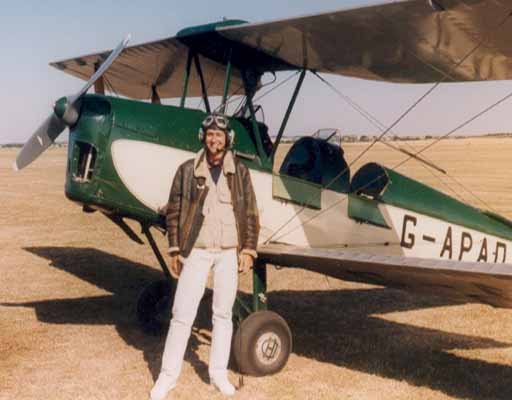 |
Many are the people who are surprised during their visit to the Air Museum of Cuatro Vientos to find themselves with a B-25 Mitchel painted with the colours of Spanish Airforce.
The Mitchel is part of a collection of unique aircraft that have formed part of the Spanish Airforce like a Catalina, various FW Condors, a Ju 290, and a long etc. About some of them we shall write later on, as these lines are dedicated to the sole B-25 Mitchel which flew with the Spanish military colours on its wings.
This aeroplane's fame is owed to its part in the first American air raid over Japan during the Second World War. On April 18th 1942 sixteen B-25B's took off from the aircraft carrier Hornet under the command of Lieutenant Colonel J.H. Doolittle, their destination Tokyo.
Entirely made of metal, this high winged twin motor resulted in an aircraft with excellent flight capabilities. Its agility, gentleness and efficiency made it one of the best aeroplanes of its time and the best medium bomber of the war.
Capable of reaching speeds of 470 km/h, with a ceiling of 6,100 m. and a range of 2,400 kms, this aeroplane operated on all the fronts during the war. From the Pacific to Russia, from Africa to China, the B-25 Mitchel proved its flight characteristics and operative efficiency. It has flown under the North American, French, British, South African, Canadian, Dutch, Brazilian and even Russian flag.
The plane, which served in the Spanish Airforce, landed at the Nador Airfield (Melilla) on August 4th 1944 in Spanish North Africa. The B-25 belonged to the USAF D-10-NC series. Its military license number was 41.30338 and construction number 87-8503. The aeroplane was flying between Casablanca and Argel and wasn't equipped as a bomber but fitted with seats for its use as a personnel transport. This B-25 that was constructed at the North American Aviation factory in Kansas City was interned in the air armoury of Morocco at the Melilla workshops.
Some years later, in 1948 it was decided to put it into flying condition, completing the objective after two years of hard work and shortages or unavailability of spare parts. On June 3rd 1950 the Armoury of Morocco releases the aircraft to Lieutenant Colonel Pombo Somoza who flies it to the Advanced Flight School in Salamanca.
With the callsign 74-17, the B-25 is flown by the instructors of the Advanced Flight School, being Lieutenant General Gonzalez Gallarza, who uses it frequently in his journeys as Air Minister, being one of the most famous pilots. The situation remains the same until September of 1953 it is moved to the workshops of Matacán (Salamanca) due to a front gear malfunction. Unfortunately, without spare parts, the aircraft remains there inactive until its retirement from service and scrapping in 1956.
How come, if the aeroplane was scraped, it is at the Air Museum you might ask? The reason is that the aeroplane at the Museum in Cuatro Vientos (Madrid) is a movie star and not the original B-25. Incorporated to the museum's aircraft collection in 1986, the B-25J-20NC was abandoned at Malaga Airport aftersuffering damage during the shooting of the film "Cuba". Donated by the Military Aircraft Restoration Corp, the plane is restored in the Air Armoury in Seville, being sent to Madrid afterwards. This aircraft bore the military registration number 44-29121 and factory number 108-33446. In its restoration it is painted as the "74-17 " and is exhibited in the museum since then.
With the years exposed to the elements, its exterior paint has deteriorated and has worsened its outer look. For this reason, since a little more then a month ago, a team of the Friend's of the Air Museum Association is working in its exterior and interior conditioning. Thanks to them, we can now see this beautiful twin-engine aeroplane in all its splendour.
Click here for spanish version
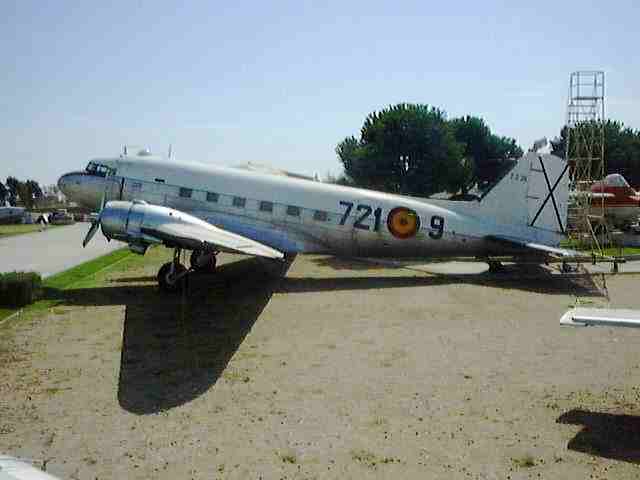
Although tempting, it is not the objective of these lines to tell the history of the DC-3. It is only to try to put together some words that remember its passage through Spain. A Story that commences in the Spanish Protectorate of Morocco in the autumn of 1943 and ends in Palma of Mallorca with the Aeromarket company a few years ago.
Spain is a special country for Douglas commercial aircraft; the only DC that hasn't flown in Spain is the DC-5. The first DC's that arrive at this country are bought through the signing of a contract written on a piece of Smoking paper in 1934. Years later the only DC-1 ever built flew through these lands. A survivor of the Civil War, it is flown by Iberia until an engine failure while taking off from Malaga one morning throws it to the ground without victims, but leaving the aircraft damaged beyond repair. But, such an extraordinary aircraft such as the DC-3 had to make a special kind of arrival…
Close to the time of the Allied landing at Casablanca three confused American crews landed their aeroplanes at Spanish Morocco. One did so at Tetuan, another at Alhucemas and the third one at an open field. They were C-47 troop transports. Based on international law, Spain could send these aeroplanes to anywhere within its territory. Iberia is the company in charge of the transport of the aeroplanes to Madrid. Three legendary pilots are in command of the flight: Anslado, Pombo and Kindelán. The aeroplanes reunited at Barajas (Madrid) and negotiations with the American Embassy were made for their sale to Iberia to be converted as passenger airliners. For this purpose seats were fitted and they were air-conditioned and soundproofed. The funny thing about the incident, which is real, is the American's surprise when they found out that the Spanish pilots flew the aeroplanes without neither training nor instructions. When asked about how they did it, they answered that it was very similar to the DC-2 but more modern. They only had one doubt about the function of a little red button on the instruments panel. "You've been lucky" was the answer of the American technician, that button switched on an explosive in the panel and rendered the aeroplane useless in case of a crash-landing behind enemy lines.
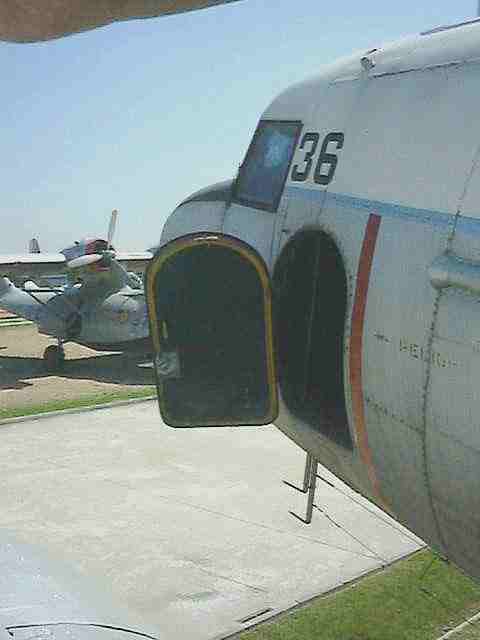
The military life of the DC-3 or T-3 in Spanish Airforce nomenclature begins in 1947 when the airforce buys from Iberia what would be known as T-3-1 and T-3-2. These aeroplanes are two of the group that arrived in such an odd way as told earlier. The T-3-1 is transferred to the Advanced Flight School at Matacan (Salamanca) and the T-3-2 is sent to Airforce High Staff Group based at Getafe (Madrid). To these first aeroplanes 5 more are added as part of the "American Aid" in 1956 with 17 more units in 1957. Years later between 1961 and 1962 30 more aeroplanes are bought directly to the Charlotte Aircraft Engineering and are registered as T.3-25 to T3-54.
A total of 67 T-3's flew for the Spanish Airforce being the last ones bought from Iberia between December 1965 and May 1966.Two additional aircraft were also flown by the Spanish Airforce but under the civilian registration numbers of EC-ENV (from October 1958 to October 1976) and EC-ARV (from 1963 to October 1976). They flew for the Aid's Verification Service (in charge of the calibration and verification of air navigational aids) under the Subsecretariate of Civil Aviation based at Barajas (Madrid). Present at nearly all the airbases and units in the country. Working as multi-motor, navigator, instrumental flight training schools, as personnel transport, mail ships, cargo haul, paratroops transport, etc., they flew over 225,000 hours during the 30 years of their operational life which ended in 1978. In all these years, only 4 fatal accidents occurred (the T.3: 1,6,37 and 44).
Let us return our look to the T.3-36 which the protagonist of our images. It is bought from the Charlotte Aircraft E. and entered service on January 10th 1962 in the Spanish Airforce. Its first destination was 35th Wing based at Getafe (Madrid) although its stay was a brief one, a few months later it was transferred to the Multi-motor Training School at Jerez del Frontera (Cadiz). From here it's moved to the 37th Transport Wing at Albacete and in 1965 it undergoes its first maintenance overhaul at CASA (Construcciones Aeronauticas SA) in Seville. Afterwards it is transferred to Matacan (Salamanca) until 1972 when it returns to Seville for another great overhaul.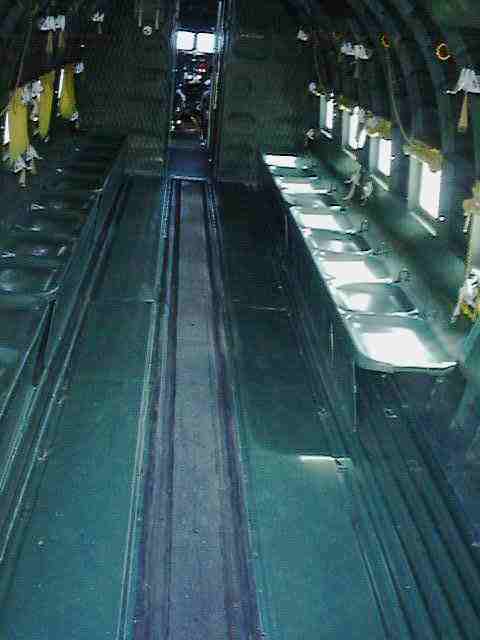
Its last years of service are spent in the sun of the Canary Islands (43rd Wing) and the Parachute Military School (721st Squadron). It is retired from active service on April 20th 1976 and deposited at the Air Armoury of Madrid until its reception in the Air Museum on October 6th 1977. Its state of exterior preservation is good, and recently works on the interior restoration have been finished. A team of the Friends of the Air Museum Association has made this complete work. We hope that in a near future in the interior can be visited, until then please enjoy the images images this report contains.
Click here for spanish version

Though designed in the late 1940s, the Saab Lansen (Lance) all-swept tandem seat aircraft combined such good qualities that a few remained in service with the Swedish air force in full service until 1979.
Reporting Rafael García Cardeña
The original A32A version was a ground attack weapon platform to replace the piston engined Saab 18 bomber, and it was noteworthy in being significantly larger and more capable than otherwise similar ‘fighters’ the being developed elsewhere. The prototype flew on 3 November 1952, and production aircraft entered in service from December 1955. The chosen engine was the British Rolls-Royce Avon turbojet fitted with a Swedish-developed afterburner and variable nozzle.The A32A had the RMA5A2 version of this engine, while the later J32B night fighter had the RM6A, derived form the more powerful Avon 200-seriesand with a new afterburner.
The third version of the Lansen is the S32C, reconnaissance aircraft, with RM5A2 engine, originally flown in March 1957 with a basic optical cameras but updated later with ECM, advanced navigation equipment and both inbuilt and podded sensors for multi-spectral reconnaissance.In 1965 they tested the electronical equipment for the Saab 37 Viggen. In 1979 the A32S had been replaced by the Saab AJ37 Viggen, and the J32B had been replaced by the Saab J35F Draken and was serving only as a target tug. A few S32C however, remained in use with F11 wing at Nykoping, though being replaced by the SF37 and SH37 versions of the Viggen.
The remaining 24 J32B aircraft were transformed into J32D target tug (12) and J32E ECM trial unit (12). In the spring of 1991 this plane was present in F13M unit 32 at Malmslatt and flied on electronic support duties: three J32B trainers, six J32D target tugs fourteen J32E electronic warfare platforms for electronic ‘aggressor’ and target facilities duties Their services were called upon to simulate electronic jamming environments.
In 1994 some units remain on service for target facilities work at Norrkoping. In 1997 the EW ‘aggressor’ of F16M were retired in a cost cutting move. On 9 November 1999, a Saab 32 Lansen came flying together with a Saab 37 Viggen from Sweden. They landed on Cuatro Vientos airport, it was the first time that a jet lands there. Both were a gift from the Sweden Air Forces to the Spanish Museum. The aircraft personnel signed up on the fuselage. You can see in the following photographs some members of the Museo del Aire Friends Association walking around the planes two days later they arrived. Now these two planes are placed in the museum in the jet zone.
Click here for spanish version
With the mission of to locate the airships crashed inside the Spanish air space or areas of Spanish responsibility and to give the necessary aid it was created January 16 1.956 the Service of Search and Air Salvage. The squadrons created to such an effect jurisdiction numbered starting from the number 50, 50 51 were created this way in Pollensa (Majorca), the 52 in Gando (Great Canaria), the 53 in Getafe (Madrid).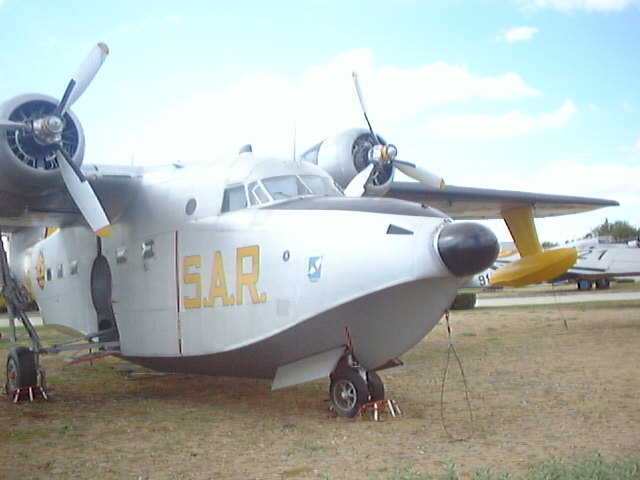
The material with which was endowed the Spanish SAR of the time was: Dornier Do-24, Sikorsky H-19B, MARRIES 2.111 (Spanish Version of the Heinkel Have-111), and the main character of our history the Grumman INC-16 TO Seabird.
Several nicknames have taken this airplane along their operative life. For the Americans it was "The Queen of the Hangar" for the complex of their maintenance, and for the Spanish fishermen it was "The Salvaora" due to the missions SAR that were commended him.
This airship has served practically in the five continents, because it has flown with the colors of it USES, Canada, Argentina, Colombia, Brazil, Italy, Portugal, Philippines, Nationalist China, Portugal, Norway, Greece and Japan.Based on the treaties of help and cooperation with the United States arrive to Getafe May of 1.954 coming from Florida 18 the Spanish first two Seabird, of a total of seven.
Not too much appreciated by their companies that missed the best seafaring conditions in the Dornier Do-24, the Seabird serves in Spain along 25 years, being moved away in December of 1.978. Of the many due anecdotes to their humanitarian works a lot is known, but maybe the but curious and not very well-known it happened in 1.956. In this year and with reason of the proclamation of the Republic of Pakistan a Seabird was good as curious official airplane to transport the general González Gallarza (in quality of Extraordinary Ambassador) from Spain until that distant country.
Once we climb for the stairway to the interior of this apparatus, he/she gets us the attention their comfortable and roomy interior, not in vain they have been carried out versions for the transport of passengers (Chalk´s in Florida) and even been modernized with turbines. Other surprising aspects are the doors of their interior "type ship", and I eat in almost all the hydroplanes or amphibious apparatuses the control of gases and of regulation of mixture of the motors they are in the superior panel among the heads of both pilots.
The Spanish Seabird of the SAR, they were it all of the version G.251, and our main character is the number of you/he/she manufactures 68 and former - USAF 51-5304. This airplane arrives in Spain January 15 1.971 and it is, finally, given to the Museum May 11 1.979. it Passed all its operative lifein the 801 squadron in the Air base of they are San Juan (Palm of Majorca). All their revisions, as those of their siblings were taken to I end up in the Air Maestranza of Seville, where it was deposited so far from August 4 1.975 from its delivery to the Museum of the Air in Four Winds.
This apparatus has been totally restored in its exterior and interior by a group of self-denying members of the association of friends of this Museum, serve as testimony the pictures that illustrate these lines.
Click here for spanish version 
T.4 was the spanish military designation for the C-54 Skymaster. This name was used previously for the Spanish Air Force to call two Fw200 Condor and later the Lookheed Lodestars who were proceeding from the CANA (Compañía Auxiliar de Navegación Aérea).But when we're talking about the T-4 denomination we're talking about the DC-4 in the Spanish Air Force.
In the early 1956 , the Air Base of Getafe, in Madrid, receive twelve Fairchild C-119F Boxcar, codified with the T.9 signs and the San Andres Cross in it's tails, to endow the Spanish Air Force of heavy transport planes. However, they are returned back to the USAF ought to it's engines complexity and it's big freight capacity never flying in service. This fact let open the way to the C-54 cause the civil DC-4 were flying for Iberia from July 1946.
The first six C-54D, arrived to Spain on May 1959 from the USAF and were named T.4-1 to T.4-6. All of them increase the 35 Transport Wing except the T.4.5, who it's assigned to the Major Staff 91 Group. Choose of this transport plane was so good to the Spanish Air Force, and it's hight quality was so impressive, that from its arrives to September 1961, they ressume almost 3.200 hours flight with an operational work near the 100% of it's capabilities. With the big success of the C-54D, the Spanish Air Force decide to buy five more planes to Charlotte Aircraft Engineering between October 1961 and March 1962.
In this just bought lot, arrives to Spain our starring, the T.4-10. Destiny to the 35 Air Wing, was transferred to the Major Staff Group in May 1962. We're talking about the C-54A (USAF c/n 42-72261 build number 10.366 and ex N-88934 ). Used to the VIP transport beneath the T.4-5, they are called lovely The Sacred Cow and The baby cow, ougth to the love in it's mainteinace for the 91 Group personal.They will pass all of it's fliying life in the 91 Squadrom and engaged to the Getafe Air Base. Both planes flight with the DC-3/C-47, Convair 440 Metropolitan, Piper PA-31 Turbo Navajo and CASA 212 Aviocar.
The T.4-10 flight almost 80.000 hours along with the whole 17 C-54 fleet with only two losses by accident. They were retired from service on December 1976. These 17 C-54 represented the axis of the Spanish Transport Air Force, prior to the actual Hercules.
The T.4-10 is donated to the Air Museum in Cuatro Vientos, Madrid, on March 10 1977 and from that year they are resting in its grass. The sectioned copkit of the T.4-5 is resting inside of the Air Museum main hangar.
Thought the T.410 is parked outdoors, its conservation state is pretty good thanks to the work made by the member of the Friends Air Museum Association who keep a very good maintenance in and outside the plane.
SPANISH AIR FORCE C-54s
Serial USAF s/n c/n Remarks T.4-1
T.4-2
T.4-3
T.4-4
T.4-5
T.4-6
T.4-7
T.4-8
T.4-9
T.4-10
T.4-11
T.4-12
T.4-13
T.4-14
T.4-15
T.4-16
T.4-17
42-72480
42-72543
43-17219
42-72607
42-72719
42-72598
44-9121
44-9087
44-9038
42-72261
44-9118
45-609
45-593
42-72633
43-17250
42-72484
42-7251410585
10648
22169
10712
10823
10703
27347
27313
27264
10366
27344
36062
36046
10738
22200
10589
10619wfu Aug 5, 2022
wfu Nov 26, 1976: to Spanish civil EC-BQK
w/o Jul 4, 1962; wfu Aug 9, 2022
wfu Dec 31, 1976: to Spanish civil EC-APD
wfu Sep 30, 2022
wfu Dec 31, 2022
wfu Dec 31, 1976: to Spanish civil EC-BXJ
wfu Apr 30, 2023
wfu Dec 31, 1976: to Spanish civil EC-BXK
wfu Dec 31, 2022
w/o Aug 9, 1976; wfu Mar 18, 1977: to Spanish civil EC-BQL
wfu Dec 31, 1976: to Spanish civil EC-BQM
wfu Jul 10, 1976: to Spanish civil EC-BXL
wfu Dec 31, 1976: to Spanish civil EC-BQH
wfu Jul 10, 1976: to Spanish civil EC-BQI
wfu Jul 10, 1976: to Spanish civil EC-BQJ
wfu Jul 10, 1976: to Spanish civil EC-APE
BONUS!! Don't miss the DC-4-6 of the series T-4 to download to your Flight Simulator.
Aircraft designer: Tom Gibson and Raf Geukens. Modified AFX: Harry Follas.
Repainted in Spanish Air Force colors: Antonio Morales.Download: t-4-6.zip
Click here for spanish version 
| FREE DOWNLOADS |
PILOTS STORIES |
AIRCRAFTS HISTORY |
SPAIN 2000 |
COOL LINKS | WHO WE ARE |
CONTACT US |